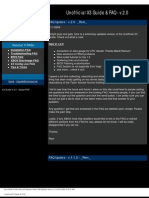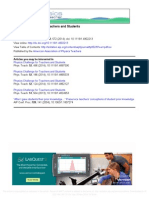Computer Science 349 Spring 2004 Due: Start of Class On Thursday February 12
Uploaded by
Donay X SmallComputer Science 349 Spring 2004 Due: Start of Class On Thursday February 12
Uploaded by
Donay X SmallAssignment 2
Computer Science 349 Spring 2004 Due: Start of class on Thursday February 12 Reading: Singh, Chapters 2, 3; Stinson, Sections 1.1.3 -- 1.1.7, 1.2.1 1.2.2. Exercise 2.0. Read the article by Robert Lemos, Psst I known your password, ZDNet News, May 22, 2002. URL: http://zdnet.com.com/2100-1105-920092.html and the article by Rob Shimonski, Introduction to Password Cracking, IBM developerWorks Hacking Techniques, July 2002. URL: http://www106.ibm.com/developerworks/security/library/s-crack . Experiment with John the Ripper (a.k.a. John) in an attempt to crack (some) passwords contained in a mock /etc/passwd file which may be downloaded from the course web page. Source code John may be found from http://www.openwall.com/john/. Program documentation is located at the same site as the program. Warning: Under no circumstances should you attempt to run John on password files other than those given in this assignment. By default, John uses the word list in password.lst in the same directory as the binary file. This is not a very extensive word list. You may want to combine it with a larger word list, such as the one in /usr/share/dict/linux.words. You might also want to include Wellesley-specific words, which you could potentially automatically generate from some documents about the campus. Note that John takes a long time to run (were talking days) indeed, it may never terminate on its own and you may have to manually terminate it. A gold star goes to the student who cracks the most passwords. As a baseline, you will have to beat 15, which is how many I cracked after running the program for 10 minutes. Submit your list of cracked passwords and associated users accounts as the solution to this exercise. Did you recognize any of your own passwords?1 Exercise 2.1. (Stinson 1.6) If an encryption function eK is identical to the decryption function dK, then the key K is said to be an involutary key. Find all involutory keys in the Shift Cipher over Z26.
The hash function used to create these accounts used only the first eight characters of your password. It was very bad of me not to tell you this in advance.
Assignment 2 Cryptography
Page 2
Exercise 2.2. (Stinson 1.10) Suppose that K = (5, 21) is a key in an Affine Cipher over Z29. a. Express the decryption function dK(y) in the form dK(y) = ay + b, where a, b Z29. b. Prove that dK(eK(x)) = x for all x Z29. Exercise 2.3. In one of his cases, Sherlock Holmes was confronted with the following message: 534 C2 13 127 36 31 4 7 21 41 DOUGLAS 109 293 5 37BIRLSTONE 26 BIRLSTONE 9 127 171 Watson, still working his way through Holmess little monograph on codes and ciphers. was stumped. Fortunately, Holmes immediately deduced the type of cipher. Having read Chapter 2 of Singh, so can you. What is it? Exercise 2.4. Sherlock Holmes was not the first investigator to benefit from cryptanalysis. Some years before The Adventure of the Dancing Men was published, Mr. William Legrand, stumbled upon Captain Kidd's treasure map complete with skull and goat's head. The fact that the map was written in invisible ink presented some small problem: "I held the vellum again to the fire, after increasing the heat, but nothing appeared. I now thought it possible that the coating of dirt might have something to do with the failure: so I carefully rinsed the parchment by pouring warm water over it, and, having done this, I placed it in a tin pan, with the skull downward, an put the pan upon a furnace of lighted charcoal. In a few minutes, the pan having become thoroughly heated, I removed the slip, and, to my inexpressible joy, found it spotted, in several places, with what appeared to be figures arranged in lines. Again I placed it in the pan, and suffered it to remain another minute. Upon taking it off, the whole was just as you see it now." The figures, transcribed from the rudely drawn originals, appear below:
The code is a simple substitution; apparently Captain Kidd didn't have a high opinion of his crew's cryptographic skills. Using the frequency table given in the text, can you figure out what it says? Warning: The resulting message is in English but may not make much sense on a first reading. It has a history.
Assignment 2 Cryptography
Page 3
Exercise 2.5. The following mystery story is from Games magazine.2 The idea is not to guess "who did it," because it is the author "who's done it." The problem is to figure out exactly what he has done. A SIN OF OMISSION Around midnight, a sly-looking man slips into a luxury city building. A woman occupant, watching his actions from a fourth-floor window, grows suspicious and dials 911 for a patrol car. This lady complains, "A man in a brown suit, with shaggy hair, a slight build, and a criminal air is prowling through my lobby." Fairly soon two young cops, Smith and Jarvis, pull up. Looking for an unknown vagrant, Smith spots Jim Oats walking out a front door. Oats, a minor burglar, is bold as brass, arrogant, and calm. Smith grabs him by his collar. "O.K, Oats," snarls Smith, "What brings you to this location?" "Fixing his captor with a chilly look and frosty indignation, Oats quips, "I can go on a short stroll. Lift your filthy hands off my shirt. I'm not guilty of anything." Smith drops his hands limply. This haughty air is too much for him to swallow. Angrily Smith says, "What a story. I'm nobody's fool, you punk. I just wish I could put you back in jail, but I can't obtain any proof against you. You know all about why I'm in this building -- a station log full of burglary, arson, and muggings." "Now, now," Oaks laughs, "think of my rights. How can you talk this way?" Smith's probing hands start to frisk Oats for guns, narcotics, anything unlawful or contraband. Nothing shows up -- only a small bound book. "That's this?" Smith asks. Oats, tidying up his clothing, pluckishly says, "That's my political study of about habits in this district. Why don't you look at my lists? I work for important politicians now -- guys with lots of clout." An ominous implication lurks in this last thrust. "Don't talk down to us," Smith snaps. But studying Oat's book, Jarvis finds nothing unusual. Smith finally hands him back his lists. Our cops can't hold him. Jarvis admits Oats can go. Just as a formality, Jarvis asks him, "Did you commit any criminal act in this building? Anything at all of which a courtroom jury could find you guilty?" "No," Oaks says flatly. "No way," and jauntily skips off. Halting six blocks away, Oats digs a tiny picklock from his sock and a diamond ring from his shaggy hair. Exercise 2.7. One way to solve the key distribution problem is to use a line from a book that both the sender and the receiver possess. Typically, at least in spy novels, the first sentence of a book serves as the key. The particular scheme discussed in this problem is from the suspense novel, Talking to Strange Men, by Ruth Rendell. Work this problem without consulting that book! Consider the following message: SIDKHKDM AF HCRKIABIE SHIMC KD LFEAILA This ciphertext was produced using the first sentence of the The Other Side of Silence (a book about the spy Kim Philby); The snow lay thick on the steps and the snowflakes driven by the wind looked black in the headlights of the cars.
2
Games magazine, November/December 1977.
Assignment 2 Cryptography
Page 4
A simple substitution cipher was used. What is the encryption algorithm? How secure is it? To make the key distribution problem simple, both parties can agree to use the first or last sentence of a book as the key. To change the key, they simply need to agree on a new book. The use of the first sentence would be preferable to the use of the last. Why?
You might also like
- Acer Predator 17 G9-793 - Pegatron MU5DC CH7DC REV 2.0No ratings yetAcer Predator 17 G9-793 - Pegatron MU5DC CH7DC REV 2.086 pages
- Syscon Error Codes - PS3 Developer WikiNo ratings yetSyscon Error Codes - PS3 Developer Wiki22 pages
- Ultimate Play Station 2 Reparation GuideNo ratings yetUltimate Play Station 2 Reparation Guide25 pages
- E3 FLASHER SLIM CONSOLE Installation Manual With ClipNo ratings yetE3 FLASHER SLIM CONSOLE Installation Manual With Clip22 pages
- plugin-XBOX 360 POT CALIBRATION V1.0 by Moda PDFNo ratings yetplugin-XBOX 360 POT CALIBRATION V1.0 by Moda PDF3 pages
- Xbox 360 Error Codes Explained and How To Fix Them - Se7enSins Gaming CommunityNo ratings yetXbox 360 Error Codes Explained and How To Fix Them - Se7enSins Gaming Community12 pages
- JQ6500 Voice Module Instruction Manual V1 - English - TranslatedNo ratings yetJQ6500 Voice Module Instruction Manual V1 - English - Translated15 pages
- RPCS3 - A PS3 Emulation Tutorial Guide - NicoBlogNo ratings yetRPCS3 - A PS3 Emulation Tutorial Guide - NicoBlog3 pages
- XBOX360 Motherboard Headers Connector v1 4100% (1)XBOX360 Motherboard Headers Connector v1 440 pages
- Sony Playstation 2 SCPH 30000 30001 30002 30003 30004 2nd Edition100% (1)Sony Playstation 2 SCPH 30000 30001 30002 30003 30004 2nd Edition127 pages
- A Complete Guide To Install Windows 95 On DOSBoxNo ratings yetA Complete Guide To Install Windows 95 On DOSBox14 pages
- The Free Information Society - Nintendo (NES) Electronic Circuit SchematicNo ratings yetThe Free Information Society - Nintendo (NES) Electronic Circuit Schematic1 page
- Using CD Enhanced Megadrive Games: Mega SD Dev Manual100% (1)Using CD Enhanced Megadrive Games: Mega SD Dev Manual6 pages
- Mods-R-Us Instruction Guide ps3 Modded ControllerNo ratings yetMods-R-Us Instruction Guide ps3 Modded Controller2 pages
- Dell Latitude 7290 LA-F311P R20 SBMLK12 13 AR MBNo ratings yetDell Latitude 7290 LA-F311P R20 SBMLK12 13 AR MB58 pages
- aHR0cDovL2lzdC51anMuZWR1LmNuL2ZpbGUvYW5zd2Vycy5wZGY PDFNo ratings yetaHR0cDovL2lzdC51anMuZWR1LmNuL2ZpbGUvYW5zd2Vycy5wZGY PDF9 pages
- Cipher Exercises - Material - Cipher-Exercises-MaterialNo ratings yetCipher Exercises - Material - Cipher-Exercises-Material25 pages
- Individual Assignment: Integrate Marketing Communication (IMC)100% (1)Individual Assignment: Integrate Marketing Communication (IMC)20 pages
- Overview CPU 315-2 DP: Micro Memory Card Required For Operation of CPUNo ratings yetOverview CPU 315-2 DP: Micro Memory Card Required For Operation of CPU9 pages
- Ap Biology Student Portfolio 2009 - 2010No ratings yetAp Biology Student Portfolio 2009 - 201019 pages
- Five Rules of Thumb For Polite and Diplomatic Language - MacmillanNo ratings yetFive Rules of Thumb For Polite and Diplomatic Language - Macmillan4 pages
- Domain Name System (DNS) in Application LayerNo ratings yetDomain Name System (DNS) in Application Layer14 pages
- Enhanced Touch Screen IP Video Phone, iPECS LIP-9071: Key BenefitsNo ratings yetEnhanced Touch Screen IP Video Phone, iPECS LIP-9071: Key Benefits2 pages
- Topics: Obtaining Information From Various Sources Persuasion and Its Rhetorical AppealsNo ratings yetTopics: Obtaining Information From Various Sources Persuasion and Its Rhetorical Appeals5 pages
- Mumbai Cyber Police Legal Demand (29/09/2019)0% (1)Mumbai Cyber Police Legal Demand (29/09/2019)3 pages
- How To Configure SnapDrive For Windows 70x With Clustered Data ONTAP 82No ratings yetHow To Configure SnapDrive For Windows 70x With Clustered Data ONTAP 822 pages
- Acer Predator 17 G9-793 - Pegatron MU5DC CH7DC REV 2.0Acer Predator 17 G9-793 - Pegatron MU5DC CH7DC REV 2.0
- E3 FLASHER SLIM CONSOLE Installation Manual With ClipE3 FLASHER SLIM CONSOLE Installation Manual With Clip
- Xbox 360 Error Codes Explained and How To Fix Them - Se7enSins Gaming CommunityXbox 360 Error Codes Explained and How To Fix Them - Se7enSins Gaming Community
- JQ6500 Voice Module Instruction Manual V1 - English - TranslatedJQ6500 Voice Module Instruction Manual V1 - English - Translated
- Sony Playstation 2 SCPH 30000 30001 30002 30003 30004 2nd EditionSony Playstation 2 SCPH 30000 30001 30002 30003 30004 2nd Edition
- The Free Information Society - Nintendo (NES) Electronic Circuit SchematicThe Free Information Society - Nintendo (NES) Electronic Circuit Schematic
- Using CD Enhanced Megadrive Games: Mega SD Dev ManualUsing CD Enhanced Megadrive Games: Mega SD Dev Manual
- aHR0cDovL2lzdC51anMuZWR1LmNuL2ZpbGUvYW5zd2Vycy5wZGY PDFaHR0cDovL2lzdC51anMuZWR1LmNuL2ZpbGUvYW5zd2Vycy5wZGY PDF
- Cipher Exercises - Material - Cipher-Exercises-MaterialCipher Exercises - Material - Cipher-Exercises-Material
- Individual Assignment: Integrate Marketing Communication (IMC)Individual Assignment: Integrate Marketing Communication (IMC)
- Overview CPU 315-2 DP: Micro Memory Card Required For Operation of CPUOverview CPU 315-2 DP: Micro Memory Card Required For Operation of CPU
- Five Rules of Thumb For Polite and Diplomatic Language - MacmillanFive Rules of Thumb For Polite and Diplomatic Language - Macmillan
- Enhanced Touch Screen IP Video Phone, iPECS LIP-9071: Key BenefitsEnhanced Touch Screen IP Video Phone, iPECS LIP-9071: Key Benefits
- Topics: Obtaining Information From Various Sources Persuasion and Its Rhetorical AppealsTopics: Obtaining Information From Various Sources Persuasion and Its Rhetorical Appeals
- How To Configure SnapDrive For Windows 70x With Clustered Data ONTAP 82How To Configure SnapDrive For Windows 70x With Clustered Data ONTAP 82

























































































